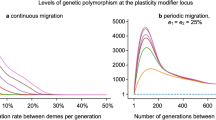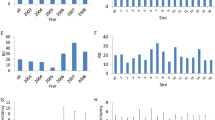Summary
The formulation of Kawecki and Stearns (1993) adapted for sexual populations is used to characterize lifehistory evolution in spatially heterogeneous environments comprising a number of distinct habitats. Three types of evolutionary outcome/optimal strategy are distinguished, appertaining to populations with phenotypic plasticity, populations without it (here called aplastic) and to populations that are reproductively isolated. In general plastic and isolated optima differ, but do not differ if none of the habitats provide source or sink populations. Plastic, aplastic and isolated optima are calculated and compared in three numerical examples representing trade-offs involving reproductive effort, egg size and defence. Locating the aplastic optimum involves numerical construction of a fitness landscape showing how allelic fitness depends on aplastic strategy and on the relative frequencies of the habitats. In all three examples the aplastic optimum lies between or almost between the plastic optima. In two cases the aplastic optimum switches abruptly between the plastic optima as the relative frequencies of the habitats change, and in the third case the switch is gradual. The abruptness or otherwise of the switch depends on the position and structure of the valleys in the fitness landscape and this in turn depends on how sharply the fitness peaks are differentiated.
Similar content being viewed by others
References
Barton, N. and Clark, A. (1990) Population structure and processes in evolution. InPopulation biology: ecological and evolutionary viewpoints (K. Wöhrmann and S.K. Jain, eds), pp. 115–73. Springer-Verlag, Berlin.
Charlesworth, B. (1994)Evolution in age-structured populations. 2nd edition. Cambridge University Press, Cambridge.
de Jong, G. (1990) Quantitative genetics of reaction norms.J. Evol. Biol. 3, 447–68.
De Meeûs, T., Michalakis, Y., Renaud, F. and Olivieri, I. (1993) Polymorphism in heterogeneous environments, evolution of habitat selection and sympatric speciation: soft and hard selection models.Evol. Ecol.,7, 175–98.
Endler, J.A. (1977)Geographic Variation, Speciation, and Clines. Princeton University Press, Princeton, NJ.
Hartl, D.L. and Clark, A.G. (1989)Principles of Population Genetics. Sinauer, Sunderland, MA.
Holt, R.D. (1985) Population dynamics in two-patch environments; some anomalous consequences of an optimal habitat distribution.Theor. Pop. Biol. 28, 181–208.
Holt, R.D. and Gaines, M.S. (1992) Analysis of adaptation in heterogeneous landscapes: implications for the evolution of fundamental niches.Evol. Ecol. 6, 433–47.
Houston, A.I. and McNamara, J.M. (1992) Phenotypic plasticity as a state dependent life-history decision.Evol. Ecol. 6, 243–53.
Kawecki, T.J. and Stearns, S.C. (1993) The evolution of life histories in spatially heterogeneous environments: optimal reaction norms revisited.Evol. Ecol. 7, 155–74.
Kozlowski, J. (1993) Measuring fitness in life-history studies.Trends in Evolution and Ecology,8, 84–5.
Levene, H. (1953) Genetic equilibrium when more than one niche is available.Am. Nat. 87, 331–3.
Levins, R. (1962) Theory of fitness in a heterogeneous environment. I. The fitness set and adaptive function.Am. Nat. 96, 361–73.
Levins, R. (1963) Theory of fitness in a heterogeneous environment. II. Developmental flexibility and niche selection.Am. Nat. 97, 75–90.
Levins, R. (1968)Evolution in Changing Environments. Some Theoretical Explorations. Princeton University Press, Princeton, NJ.
MacArthur, R.H. (1962) Some generalized theorems of natural selection.Proc. Nat. Acad. Sci. USA 38, 1893–7.
Maynard Smith, J. (1989)Evolutionary Genetics. Cambridge University Press, Cambridge.
Pianka, E.R. (1970) Onr- andK-selection.Am. Nat. 104, 592–7.
Pulliam, H.R. (1988) Sources, sinks, and population regulation.Am. Nat. 132, 652–61.
Pulliam, H.R. and Danielson, B.J. (1991) Sources, sinks, and habitat selection: a landscape perspective on population dynamics.Am. Nat. 137, S50–66.
Ricklefs, R.E. (1990)Ecology. W.H. Freeman, New York.
Roff, D.A. (1992)The Evolution of Life Histories: Theory and Analysis. Chapman & Hall, London.
Sibly, R.M. and Antonovics, J. (1992) Life-history evolution. InGenes in Ecology (R.J. Berry, T.J. Crawford and G.M. Hewitt, eds), pp. 87–122. Blackwell Scientific Publications, UK.
Sibly, R.M. and Calow, P. (1985) Classification of habitats by selection pressures: a synthesis of life-cycle andr/K theory. InBehavioural Ecology: Ecological Consequences of Adaptive Behaviour (R.M. Sibly and R.H. Smith, eds), pp. 75–90. Blackwell Scientific Publications, Oxford.
Sibly, R.M. and Calow, P. (1986)Physiological Ecology of Animals. Blackwell Scientific Publications, Oxford.
Sibly, R.M. and Calow, P. (1987) Ecological compensation — a complication for testing life-history theory.J. Theor. Biol. 125, 177–86.
Sibly, R.M. and Calow, P. (1989) A life-cycle theory of responses to stress.Biol. J. Linn. Soc. 37, 101–16.
Sibly, R.M. and Curnow, R.N. (1993) An allelocentric view of life-history evolution.J. Theor. Biol.,160, 533–46.
Stearns, S.C. (1992)The Evolution of Life Histories. Oxford University Press, Oxford.
Stearns, S.C. and Koella, J. (1986) The evolution of phenotypic plasticity in life-history traits: predictions for norms of reaction for age- and size-at-maturity.Evolution 40, 893–913.
Via, S. and Lande, R. (1985) Genotype—environment interaction and the evolution of phenotypic plasticity.Evolution 39, 505–22.
Author information
Authors and Affiliations
Rights and permissions
About this article
Cite this article
Sibly, R.M. Life-history evolution in spatially heterogeneous environments, with and without phenotypic plasticity. Evol Ecol 9, 242–257 (1995). https://doi.org/10.1007/BF01237771
Issue Date:
DOI: https://doi.org/10.1007/BF01237771




